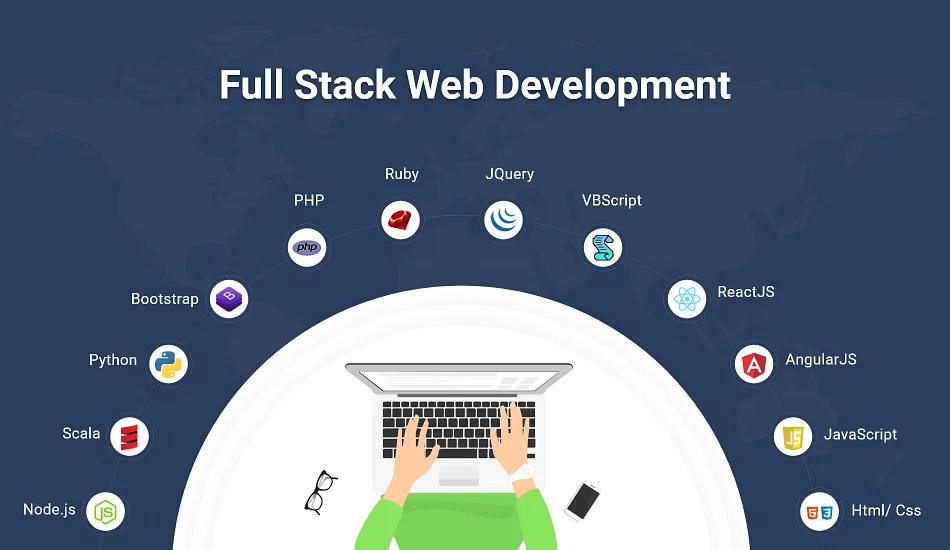
In this Article we discuss that, BIG DATA IMPACT YOUR BUSINESS IN 2023? The size of the global Big Data market is expanding annually. Making judgements based on data. One of the most important factors to take into account is selecting the appropriate tech stack for web development stacks. After all, it will define the software’s features, functionality, and user interface, which will ultimately affect many different levels of your company.
Hours could be spent researching the several current programming language trends, but first you must wade through a number of high-end technology. However, business owners may still find it confusing even after spending numerous hours searching.
So let’s clear things up and learn what a web development stack is and what tools and technology fuel the software development process. Then, we shall consider them from the point of view of their place in the software development anatomy. That will eventually allow us to narrow down the most popular programming languages in 2023.
What Is A Web Development Stack?

Imagine you’ve had a wonderful concept for a web app and are confident it will be the next big thing in your sector. To ensure that no rival gets an advantage, you must start with an effective, flawless, and speedy development process.
The easiest approach to accomplish those goals is to rely on a collection of tested technologies that developers may combine. Stacks for web development come in handy in this situation.
As a result, the tech stack is the amalgamation of several supporting technologies utilised to create the data architecture that aids in the running and deployment of an application. The tech stack not only influences technical aspects but also aids in detailing crucial business decisions.
Based on a chosen tech stack, business owners can evaluate what capabilities they require to fill development teams. Also, they can narrow down the range of options they can provide the market and consumers and assess the predicted effectiveness of the development endeavor.
To assist organisations in developing new applications, various web development stacks are available. They can support the two typical web development components in a variety of roles. Let’s look at them now.
Read More: WHAT DIFFERSENTIATES ERP Vs CRM?
Web Development Anatomy

Web development is best seen as a two-way process, as follows:
Front-end, often known as client-side programming, is the user-focused portion of a website or app. Users can access, interact with, and edit its various components. The following elements should be included in the front-end of an application for it to be dependable and performant:
UI: user interface a visual representation of the data the front-end component has provided;
In order to provide information to the end user, markup language is an encoding system that manages and organises the material on a website or in an application. Its markup counterpart, as contrast to a programming language, is merely in charge of establishing the guidelines for how the textual portions of the content are presented in a browser;
The main instrument in the best web development stacks for delivering interaction and engagement to the user experience is a programming language.
Back-end or server-side programming refers to the portion of a website or app that is hidden from end users. It includes a number of background processes that offer a means of responding to HTTP requests and handling them in accordance with pre-defined logic.
To carry out the project properly, it is important to consider both aspects of web development. Your product will satisfy exacting market demands and maintain its consistency with them.
Many stack types are available in the present technology environment for web development, which can aid in the implementation of typical use cases. Some are most effective in ensuring the scalability, usability, and stability of a programme. Additional technologies are incorporated into the finest tech stacks for quick development, reducing time-to-market and keeping clients ahead of rivals.
ck elements that address its needs and goals. Some, however, have gained popularity and are included on the list of the top tech stacks for 2023. Let’s examine them.
Read More: USA Software Engineer Hourly Rate in 2023?
The Popularity of Web Development Technologies

According to recent studies, Java, Python, and Javascript are the most often used technologies to power web development. According to the new CodinGame developer poll, these are the programming languages that recruiters will be looking for the most in 2023.
Another poll by Statista found that the following languages are most frequently used by developers:
HTML, JavaScript, and CSS
Python SQL Java.
The popularity of particular programming languages on search engines is another factor that influences our decision to select them from the greatest tech stacks. We took into consideration the leading candidates in the frequently updated TIOBE and PYPL ratings for that.
According to the TIOBE index, Python, C, C++, Java, C#, Visual Basic, and JavaScript are the leading candidates. Python maintained its top spot for a second consecutive year, as shown in the table below. Nonetheless, C++’s popularity increased the highest in 2023. It overcame Java and into the top three on the TIOBE’s list of programming languages.
The leading winners have retained their positions through 2023, according to the PYPL rating, which examines the most popular programming languages and technologies:
We can present the most in-demand programming technologies for use in 2023 at various stages of the web development process and for other reasons thanks to the most recent research data.
Front-End Technology Stack Components

The work of a modern front-end developer would be difficult to imagine without the most widely used technologies available:
CSS and HTML (Hypertext Markup Language) (Cascading Sheet Styles). Each web page’s frame is made with the use of HTML. Next CSS integrates to change the page and give it a polished appearance.
The findings of Stackoverflow 2022 show that among experienced engineers, JavaScript is the most popular technology. The second spot on the list was taken by HTML/CSS.
With HTML and CSS, there are useful frameworks that should be used. Developers favour Foundation and Bootstrap the most out of all of them. Bootstrap makes it easier to construct responsive websites that look the same in all current browsers and cuts down on development time. When creating the interface, developers have additional freedom thanks to Foundation. It provides a wide range of capabilities that make it easier to create expansive business websites.
JavaScript. It is a programming language that works within the browser and gives a web page more capability and interactivity.
Developers and businesses continue to show a keen interest in the technology, as seen by the adoption trends for current programming languages. According to the information gathered by the researchers (CodinGame and Stackoverflow) previously mentioned:
| CodinGame | Stackoverflow |
|---|---|
| JavaScript developers are needed by 62% of recruiters. JavaScript is used by 64% of programmers. |
JavaScript is used by 68% of programmers. |
Without specialised toolkits that speed up web development and offer a structured arrangement of the code, no Javascript tech stack is complete. The most popular frameworks are jQuery, Angular.js, React.js, and Vue.js among them. Knowing their features and application areas is crucial because each of them has certain tasks that need to be accomplished.
About jQuery, it helps HTML and JavaScript interact while also resolving cross-browser compatibility problems. The technology giant Google created Angular.js, and it will continue to be used for a long time. It is mainly utilised to create dynamic web applications and SPAs (Single-Page Apps).
Comparatively, Facebook created React.js, which is renowned for its effectiveness. The framework Vue.js is quite young, simple to use, and necessitates some familiarity with HTML and JavaScript. It is important to note that Vue is a free and open-source framework that is not affiliated with any well-known tech enterprise.
Looking at the results of StackOverflow’s study, we can see that Node.js and React.js are the most popular web development frameworks overall.
Back-End Technology Stack Components
The following elements make up the back-end portion:
Databases, Programming Languages, and Servers
Programming Languages

Interoperability between databases, servers, and the front end of a website or app is provided through programming languages.
Which coding languages are used in the top web development stacks throughout the world? The following are the most frequent mentions:
Python is helpful for creating complicated apps that use the Django, Pylons, and Flask frameworks. Given that it is one of the most in-demand programming languages among companies, it is among the best in 2023
Programmers (developers) utilise a programming language, which is a computer language, to communicate with computers. It is a set of guidelines created in any particular language (C, C++, Java, Python), developed to carry out a certain task.
A runtime environment called NodeJS is used to build server-side applications. Because it necessitates an understanding of JavaScript, which is frequently utilised in stacks alongside the JS front-end infrastructure.
Programming with Java is quick, scalable, and secure. It frequently pairs with the Hibernate, Struts, and Spring frameworks.
PHP is a widely used programming language, and one of the most well-liked PHP frameworks is Laravel.
The Unity Game Engine is powered by C#, which is widely used on the.NET framework and any open-source platform.
Writing quick programmes for operating systems, browsers, graphics programmes, banking software, and many more applications requires the use of C++.
The main back-end technologies are contrasted in the table below.
Databases

Databases offer the permanent archiving of data. They can be relational or not in a relationship.
Let’s make another reference to the StackOverflow survey. We discover that the PostgreSQL database is the most popular choice since it provides one of the most thorough coverages of trends among professional developers.
The graph shows the proportion of respondents who chose a particular technology.
This information places PostgreSQL at the top of the global rankings, closely followed by MySQL. Yet, due to its user-friendly interface and batch commands that can dependably process enormous amounts of data, MySQL has maintained its lead in the market. Although it is routinely updated and enhanced in terms of security, the programme is also free.
Servers

34% of all websites currently use NGINX, according to statistics gathered by W3Techs. The server is typically picked because of its excellent performance and scalability. The answer is quite good at managing lots of concurrent sessions.
Any server, network computer, software, or device that handles client requests (see client-server architecture). For instance, a Web server on the World Wide Web is a computer that utilises the HTTP protocol to transfer Web pages to a client’s computer in response to a client request.
IIS. The Windows platform is used to create this web server. This server is appropriate for those who don’t enjoy configuring files on the command line because all the settings are set up via a graphical interface. This is the justification for some people choosing IIS over the command-line-based Apache.
Now that you are familiar with the basic elements of web development, let’s move on to the full-stack solutions that rule the sector.
Full-Stack Tech Components

The following stacks are the most common:
LAMP MEAN MERN Python-Django Stack
LAMP Stack
The Linux, Apache, MySQL, and PHP (LAMP) stack) is an open-source software package that is free to use. LAMP has stood the test of time as the industry standard for web development.
Each operating system and nearly every Linux distribution can run the LAMP stack. Developers can support projects that depend on continuing content modifications because it manages dynamic pages. Moreover, its parts can be changed and swapped out within the same generic stack.
Because to its dependability and agility, LAMP serves as a strong basis for well-known systems like Shopify, WordPress, and Drupal. It enables entrepreneurs to build scalable and effective websites and applications.
MEAN Stack
The three JavaScript frameworks (ExpressJS, AngularJS, and NodeJS) plus a document-oriented NoSQL (MongoDB) database are combined under the moniker MEAN. JavaScript is the sole programming language that can be used to create MEAN applications because it is used to create ExpressJS, AngularJS, and NodeJS. It, along with the tech stack’s superior flexibility and easy code transfer, is one reason why it continues to be popular.
With the help of the open-source MEAN stack, app developers can produce applications fast and cheaply. It is excellent at delivering apps and websites that must handle brief traffic peaks. Businesses utilise the MEAN stack to create calendar and route-finding applications, streaming apps, news aggregator websites, and single-page applications (SPAs).
MERN Stack
MongoDB, ExpressJS, React/Redux, and NodeJS make up MERN. Because it used NodeJS for the back-end and ReactJS for the front-end, it became incredibly popular. It is frequently utilised to build high-performance pre-built web apps.
The fundamental technologies of the MERN stack facilitate the development and deployment of social networking networks, news aggregation apps, websites, and task management apps. This web development technology stack is used by Netflix and Uber.
Python-Django Stack
The Python-Django stack is anticipated to stay on the list of top web development stacks through 2023 and beyond because it is built on one of the most widely used web development languages.
For server-side development, developers typically pair it with the Apache web server, MySQL, and the Django framework. Due to the wide variety of third-party packages available, Django is the ideal choice for any website. Being proficient with Javascript is necessary if you want to design a complicated user experience.
Moreover, businesses may quickly develop, implement, and grow some web applications using the Python-Django tech stack. This full-stack solution was chosen by Instagram, Disqus, and Piterest due to its utility and capacity to account for expanding user bases. Django makes it simple to manage increasing traffic volumes, API requests, and evolving business needs.
Conclusion
This post concentrated on the tool ecosystem that will support contemporary web development in 2023. We wanted to identify the tech stacks that emerge and explain why they are so popular.
Visit the second half of our blog posts for more useful guidance on selecting the appropriate tech stack based on the scope and complexity of the project. You will gain an overview of the technologies influencing the creation of contemporary web applications. Also, we look into the tech stacks used by successful projects in our next publication. Remain tuned!












7 Comments